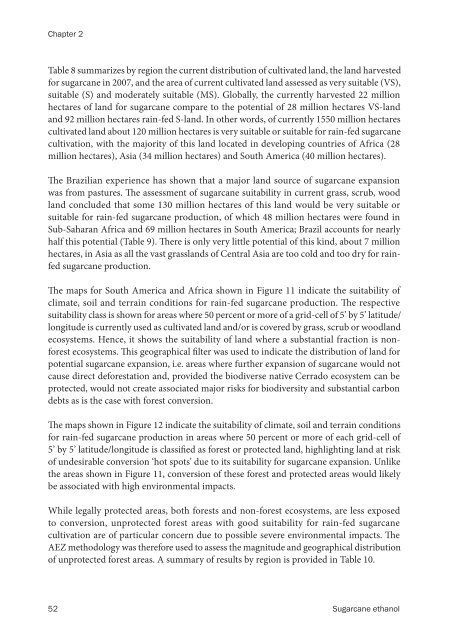Sugarcane ethanol: Contributions to climate change - BAFF
Sugarcane ethanol: Contributions to climate change - BAFF
Sugarcane ethanol: Contributions to climate change - BAFF
Create successful ePaper yourself
Turn your PDF publications into a flip-book with our unique Google optimized e-Paper software.
Chapter 2<br />
Table 8 summarizes by region the current distribution of cultivated land, the land harvested<br />
for sugarcane in 2007, and the area of current cultivated land assessed as very suitable (VS),<br />
suitable (S) and moderately suitable (MS). Globally, the currently harvested 22 million<br />
hectares of land for sugarcane compare <strong>to</strong> the potential of 28 million hectares VS-land<br />
and 92 million hectares rain-fed S-land. In other words, of currently 1550 million hectares<br />
cultivated land about 120 million hectares is very suitable or suitable for rain-fed sugarcane<br />
cultivation, with the majority of this land located in developing countries of Africa (28<br />
million hectares), Asia (34 million hectares) and South America (40 million hectares).<br />
�e Brazilian experience has shown that a major land source of sugarcane expansion<br />
was from pastures. �e assessment of sugarcane suitability in current grass, scrub, wood<br />
land concluded that some 130 million hectares of this land would be very suitable or<br />
suitable for rain-fed sugarcane production, of which 48 million hectares were found in<br />
Sub-Saharan Africa and 69 million hectares in South America; Brazil accounts for nearly<br />
half this potential (Table 9). �ere is only very little potential of this kind, about 7 million<br />
hectares, in Asia as all the vast grasslands of Central Asia are <strong>to</strong>o cold and <strong>to</strong>o dry for rainfed<br />
sugarcane production.<br />
�e maps for South America and Africa shown in Figure 11 indicate the suitability of<br />
<strong>climate</strong>, soil and terrain conditions for rain-fed sugarcane production. �e respective<br />
suitability class is shown for areas where 50 percent or more of a grid-cell of 5’ by 5’ latitude/<br />
longitude is currently used as cultivated land and/or is covered by grass, scrub or woodland<br />
ecosystems. Hence, it shows the suitability of land where a substantial fraction is nonforest<br />
ecosystems. �is geographical �lter was used <strong>to</strong> indicate the distribution of land for<br />
potential sugarcane expansion, i.e. areas where further expansion of sugarcane would not<br />
cause direct deforestation and, provided the biodiverse native Cerrado ecosystem can be<br />
protected, would not create associated major risks for biodiversity and substantial carbon<br />
debts as is the case with forest conversion.<br />
�e maps shown in Figure 12 indicate the suitability of <strong>climate</strong>, soil and terrain conditions<br />
for rain-fed sugarcane production in areas where 50 percent or more of each grid-cell of<br />
5’ by 5’ latitude/longitude is classi�ed as forest or protected land, highlighting land at risk<br />
of undesirable conversion ‘hot spots’ due <strong>to</strong> its suitability for sugarcane expansion. Unlike<br />
the areas shown in Figure 11, conversion of these forest and protected areas would likely<br />
be associated with high environmental impacts.<br />
While legally protected areas, both forests and non-forest ecosystems, are less exposed<br />
<strong>to</strong> conversion, unprotected forest areas with good suitability for rain-fed sugarcane<br />
cultivation are of particular concern due <strong>to</strong> possible severe environmental impacts. �e<br />
AEZ methodology was therefore used <strong>to</strong> assess the magnitude and geographical distribution<br />
of unprotected forest areas. A summary of results by region is provided in Table 10.<br />
52 <strong>Sugarcane</strong> <strong>ethanol</strong>












